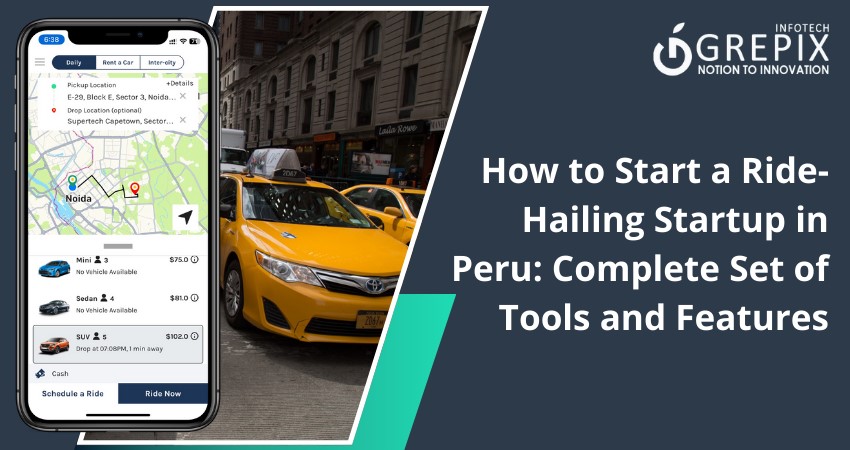How to Start a Ride-Hailing Startup in Peru: Complete Set of Tools and Features
Looking to launch a ride-hailing startup in Peru? Whether you're inspired by Uber, DiDi, or a local innovator like Cabify, tapping into this lucrative and growing market is no small feat. Peru, particularly its capital Lima, has seen a sharp rise in digital transportation use due to urban congestion, economic shifts, and increasing smartphone penetration. But how do you stand out in a market dominated by giants? This guide dives deep into how to build a successful ride-hailing business from the ground up covering everything from market analysis and tech stack to local regulations and monetization.
Launching a ride-hailing startup in Peru offers immense potential amid growing urbanization, smartphone usage, and tourism. Cities like Lima, Arequipa, and Cusco are embracing digital transport solutions, yet challenges like informal services and complex regulations remain. This comprehensive guide outlines key strategies for success from understanding Peru’s regulatory landscape and choosing the right service model to selecting the ideal tech stack and crafting targeted marketing campaigns. With insights into funding, compliance, and scaling opportunities, it equips aspiring entrepreneurs with a clear roadmap. Partnering with Grepix Infotech, a global leader in taxi app development, ensures you have the technology, tools, and support to stand out and thrive in Peru’s competitive mobility market.
1Introduction: Peru Taxi Market Overview
Peru's taxi market is experiencing a significant transformation, driven by urbanization, technological advancements, and evolving consumer preferences. In 2024, the ride-hailing sector in Peru was valued at approximately USD 785.35 million, with projections indicating a growth rate of 8.6% CAGR through 2031.
Key Market Drivers:
- Urbanization: Major cities like Lima, Cusco, and Arequipa are witnessing increased demand for reliable transportation due to population growth and tourism.
- Smartphone Penetration: With over 80% smartphone usage, there's a substantial user base for app-based taxi services.
- Tourism: Peru's rich cultural heritage and attractions draw millions of tourists annually, necessitating efficient transportation solutions.
Challenges:
- Informal Services: A significant portion of taxi services operate informally, leading to concerns about safety and reliability.
- Regulatory Hurdles: Navigating the complex regulatory environment can be challenging for new entrants.
2Understanding Peru's Regulatory Environment
Launching a ride-hailing startup in Peru requires a thorough understanding of the country's regulatory landscape.
1. Licensing and Compliance
- Business Registration: Register your company with the National Superintendency of Public Registries (SUNARP) and obtain a RUC (Unique Taxpayer Registry) number.
- Municipal Permits: Secure necessary permits from local municipalities where you intend to operate.
- Driver Requirements: Ensure all drivers possess valid licenses and comply with local regulations.
2. Insurance and Safety
- Mandatory Insurance: All vehicles must have SOAT (Obligatory Traffic Accident Insurance) coverage.
- Vehicle Inspections: Regular technical inspections are mandatory to ensure vehicle safety standards are met.
3. Digital Platform Regulations
The Peruvian government is actively working on regulations for digital ride-hailing platforms to ensure fair competition and consumer protection.
3Conducting In-Depth Market Research
Before launching, it's crucial to understand the market dynamics, customer preferences, and competitive landscape.
1.Target Audience Analysis
- Commuters: Daily travelers seeking reliable transportation.
- Tourists: Visitors requiring convenient travel options.
- Corporate Clients: Businesses needing transportation solutions for employees.
2. Competitor Analysis
- Existing Players: Study established services like Uber, Cabify, and local operators to identify gaps and opportunities.
- Service Offerings: Analyze the features, pricing, and customer feedback of competitors.
3. Customer Preferences
- Safety: High priority on driver background checks and vehicle conditions.
- Convenience: User-friendly apps with real-time tracking and multiple payment options.
- Affordability: Competitive pricing models to attract cost-conscious users.
4Defining Your Service Model and Target Audience
Choosing the right service model and understanding your target audience are pivotal for success.
1. Service Models
- Aggregator Model: Connecting riders with independent drivers through a digital platform.
- Fleet Ownership: Operating a company-owned fleet of vehicles and employing drivers.
- Hybrid Model: Combining both aggregator and fleet ownership approaches.
2. Target Audience Segmentation
- Urban Professionals: Offering premium services for daily commuters.
- Tourists: Providing multilingual support and curated travel experiences.
- Corporate Clients: Customized solutions for business transportation needs.
Also Read: "Accelerating Your Fortune: Becoming a Billionaire in South Africa's Taxi Industry"
5Vehicle Acquisition and Driver Recruitment
Building a reliable fleet and recruiting competent drivers are foundational steps.
1. Vehicle Acquisition
- Purchasing: Investing in new or used vehicles that meet safety and comfort standards.
- Leasing: Partnering with financial institutions or leasing companies to acquire vehicles.
- Driver-Owned Vehicles: Allowing drivers to use their vehicles, subject to compliance checks.
2. Driver Recruitment
- Background Checks: Conduct thorough screenings to ensure safety and reliability.
- Training Programs: Offer training on customer service, app usage, and road safety.
- Incentive Structures: Implement reward systems to retain high-performing drivers.
6Choosing the Right Dispatch Technology
Your taxi dispatch system is the backbone of your ride-hailing startup. Get this wrong, and you'll lose both drivers and passengers. Choose wisely.
Core Features of a Taxi Dispatch System
- Real-Time GPS Tracking: Know where your drivers are at all times. Riders love accurate ETAs.
- Automated Matching: Assign rides to nearby drivers efficiently.
- In-App Payments: Allow card, cash, and wallet payments within the app.
- Driver and Passenger Ratings: Keep quality in check on both sides.
You don't need to reinvent the wheel. Platforms like Onde or JungleWorks offer white-label taxi app solutions that can be customized for the Peruvian market. They're as functional as any taxi app Sydney services like 13CABS or GoCatch.
Tech Tips:
- Start simple, scale fast: Begin with a minimal viable product (MVP) and build up based on user feedback.
- Go mobile-first: Most Peruvians will access your service via smartphone, not desktop.
Extra Tools to Consider
- Driver analytics dashboard: To monitor performance and route efficiency.
- CRM integrations: To handle customer service tickets.
- Push notifications: For promotions or alerts.
Pro Tip: If your tech partner also powers a taxi service in Sydney, check their reliability and uptime. A proven track record in competitive markets can be your green flag.
7Crafting an Effective Marketing Strategy
You've got your tech. Now let's get people to download your app.
1. Targeting Locals and Tourists Alike
- Local Marketing Channels: Radio ads, Facebook groups, and transit posters.
- Tourism Partnerships: Team up with hotels, airports, and tour operators.
- Referral Incentives: Offer discounts for users who invite friends.
2. Branding Matters
Your brand should scream trust and reliability. Peruvians are cautious, especially when it comes to transportation. Use testimonials and real-driver stories to build social proof.
3. Digital Marketing Tactics
- Search Engine Optimization (SEO): Use terms like "start a taxi business in Peru" in your blog and FAQs.
- Google Ads & Facebook Ads: Target people in Peru searching for transportation or tourist travel.
- App Store Optimization (ASO): Use keywords like "ride app Peru," "cheap taxi Lima," and "safe taxi Arequipa" in your app listing.
4. Offline Marketing Still Works
- Sponsor local events or sports teams.
- Hand out branded merchandise.
- Set up demo stations in malls or airports.
Key Takeaway: If a Sydney taxi license can cost over AUD 100,000 due to branding and reputation, imagine the value your brand will hold if people associate it with safety and speed in Lima.
8Financial Planning, Funding & Pricing Models
Now it's time to talk money. Starting a ride-hailing business isn't cheap, but it doesn't have to bankrupt you either.
1. Cost Breakdown
- Tech Stack: $10,000–$25,000 upfront or $1,500/month with white-label providers.
- Driver Onboarding & Training: ~$50–$100 per driver.
- Marketing: At least $5,000 for the first launch phase.
- Insurance and Legal Fees: $3,000+ depending on scope.
2. Funding Options
- Bootstrapping: Ideal if you want full control and have initial capital.
- Angel Investors: Tap into local startup ecosystems or Latin American VC networks.
- Bank Loans or Government Grants: SUNAT and COFIDE may have small business programs.
3. Pricing Models to Explore
- Flat-Rate Fares: Simple and easy to market.
- Dynamic Pricing: Surge pricing during peak hours, similar to Uber.
- Subscription Models: Monthly ride packages for corporate clients or frequent users.
4. Revenue Tips
- Take 20-30% commission on each ride.
- Upsell premium rides or offer ride insurance.
- Launch in-app ads or local promotions to generate side income.
Important Note: Always keep your financial model adaptable. What works in a taxi company setup in Sydney might not translate directly to the Peruvian market, where affordability can make or break your brand.
9Risk Management, Insurance & Compliance
Risks are part of every business, but you can minimize them with smart planning.
1. Top Business Risks
- Accidents and Injuries: Leads to lawsuits and loss of reputation.
- Driver Misconduct: Can scare away users fast.
- Tech Failures: A crashy app means lost revenue and trust.
2. Mitigation Strategies
- SOAT: Required by law.
- Liability Insurance: Protects against passenger claims.
- Vehicle Insurance: Covers repair/replacement.
3. Comprehensive Insurance Coverage:
4. Driver Background Checks
- Criminal history
- Driving record
- Drug tests (where applicable)
5. App Security
- End-to-end encryption
- Secure payment gateways
- Regular vulnerability audits
6. Legal Compliance Musts
- Pay taxes under RUC.
- File financial statements annually.
- Keep contracts with all drivers and staff.
Pro Insight: Just like a Sydney taxi license holder needs to meet strict government standards, your ride-hailing startup in Peru must remain fully compliant to maintain operational licenses.
10Step-by-Step Launch Checklist
Here's a quick launch roadmap to keep you on track.
1. Pre-Launch Phase
- Register your business and acquire permits.
- Finalize your app's development.
- Recruit and train 20–50 initial drivers.
- Prepare marketing assets and landing page.
2. Launch Week
- Host a launch event or online promo.
- Offer ride discounts for first-time users.
- Push press releases to local media.
- Monitor app performance and user feedback.
3. Post-Launch
- Launch customer support (live chat, WhatsApp, email).
- Onboard 10–20 new drivers per week.
- Adjust pricing based on early usage patterns.
- Run weekly email campaigns or push offers.
Golden Rule: Test everything—app features, support systems, promo codes—before going live.
11Scaling Your Taxi Business for Growth
Once your taxi business is up and running, it's time to think bigger. Scaling isn't just about adding more cars or drivers, it's about building a sustainable system that can grow with demand.
1. Expand Geographically
- Start with major cities: After Lima, consider expanding to Arequipa, Trujillo, and Cusco. These cities have growing populations and limited competition.
- Tourism hubs: Tap into regions with heavy tourist traffic. Offering English-language support and local guides can be a unique selling point.
2. Add New Services
- Carpooling: Let users share rides and split costs.
- Luxury Ride Options: For executives and high-end tourists.
- Delivery Services: Use idle drivers to offer local package or food delivery.
3. Leverage Technology for Scale
- Implement AI for route optimization and predictive demand.
- Introduce loyalty programs or subscription packages using CRM tools.
- Use data analytics to refine operations, like identifying driver performance gaps or peak-hour trends.
4. Build Strategic Partnerships
- With businesses: Offer employee ride packages.
- With tourism boards and travel companies: Create bundled services or promote your app through tourism channels.
- With local governments: Participate in smart city projects or public-private transport initiatives.
Real Talk: A successful taxi app Sydney company doesn't rely on luck—they use data, tech, and customer-centric strategies. You should too.
Conclusion
Starting a taxi company in Peru comes with its fair share of challenges—from navigating regulatory frameworks and recruiting drivers to developing a reliable, user-friendly app. But you don’t have to go it alone.
Grepix Infotech, a global leader in taxi app development, brings years of experience and deep industry insight to help entrepreneurs like you turn ambitious ideas into scalable businesses. Whether you're planning to replicate the success of Uber, DiDi, or Cabify, or aiming to disrupt the Peruvian market with a hyper-localized solution, Grepix equips you with everything you need to succeed.
Our white-label taxi app solutions are fully customizable, multilingual, and designed to meet the unique demands of the Latin American ride-hailing market. From real-time GPS tracking, automated dispatch, and in-app payments to driver analytics dashboards and secure backends, we offer enterprise-grade tools without the enterprise-level cost.
Looking to launch your ride-hailing startup in Peru? Partner with Grepix and gain a competitive edge with a proven tech stack, pre-launch guidance, post-launch support, and a strategic roadmap tailored to the Peruvian landscape. Start smart, scale fast and ride the wave of digital mobility with confidence.
🚖 Grepix: Powering the future of transportation, one ride at a time.
FAQs
1. Do I need to own vehicles to start a ride-hailing startup in Peru?
No. Many successful platforms operate under an aggregator model where drivers use their own cars. It reduces capital investment and speeds up your launch.
2. How do I ensure drivers are trustworthy and safe?
Run comprehensive background checks, require SOAT and insurance documents, and implement a rating system for passengers to report any issues.
3. What's the best pricing model for a new taxi service?
Start with competitive flat rates or slightly undercut market leaders. Use promo codes for first rides, and explore dynamic pricing later.
4. Can I use a dispatch platform made for a taxi license holder in Peru?
Yes, as long as it supports local payment systems, language preferences, and compliance needs. Make sure it's customizable.
5. How long does it take to break even?
Most startups see positive cash flow within 12–18 months, depending on driver base size, operational costs, and user acquisition speed.
Looking out to start your own venture like Uber? Try out our HireMe Taxi Uber Clone, the easiest way to kick-start your taxi business.







